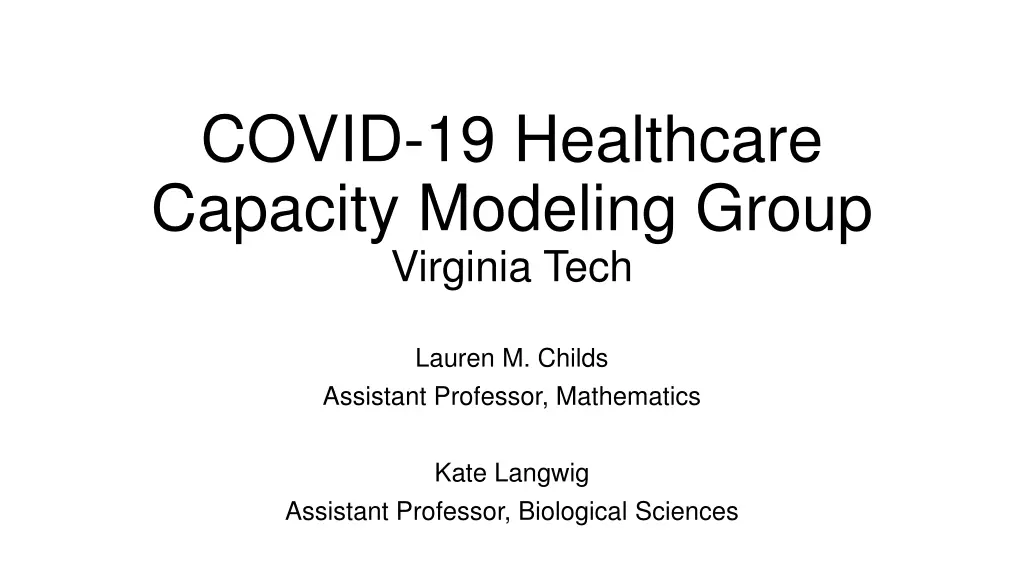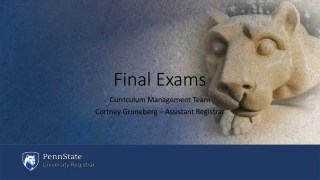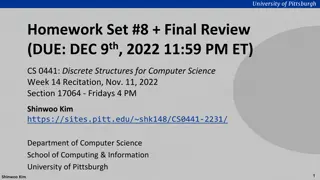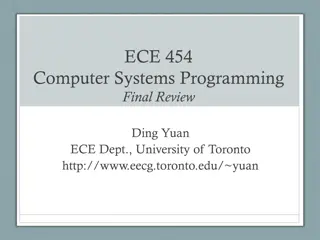
COVID-19 Healthcare Capacity Modeling at Virginia Tech
"Explore the COVID-19 healthcare capacity modeling group at Virginia Tech led by Lauren M. Childs and Kate Langwig. Goals include understanding outbreak risks, comparing intervention strategies, and focusing on various individuals. Current limitations, disease state model, healthcare capacity in Montgomery County, and scenarios considered are discussed. Dive into this research initiative for valuable insights."
Download Presentation

Please find below an Image/Link to download the presentation.
The content on the website is provided AS IS for your information and personal use only. It may not be sold, licensed, or shared on other websites without obtaining consent from the author. If you encounter any issues during the download, it is possible that the publisher has removed the file from their server.
You are allowed to download the files provided on this website for personal or commercial use, subject to the condition that they are used lawfully. All files are the property of their respective owners.
The content on the website is provided AS IS for your information and personal use only. It may not be sold, licensed, or shared on other websites without obtaining consent from the author.
E N D
Presentation Transcript
COVID-19 Healthcare Capacity Modeling Group Virginia Tech Lauren M. Childs Assistant Professor, Mathematics Kate Langwig Assistant Professor, Biological Sciences
Goals for our model Understand risk to healthcare capacity of outbreaks in Blacksburg and at Virginia Tech Compare potential intervention strategies at reducing outbreak size, duration, and severity Account for time scales impacting healthcare capacity (hospitalization length, ICU usage) not directly evident from cases counts
Current limitations All data is from publicly available sources. More accurate, detailed data likely exists. Contact structure and interactions are difficult to precisely quantify. No variation in healthcare capacity is considered. No temporal variation in mitigation measures or contact structure is considered.
Focus on three types of individuals Off-campus students, faculty, staff On-campus students Blacksburg community
Schematic of disease-state model S = susceptible E0 = exposed but cannot transmit E1 = pre-symptomatic (can transmit) I0 = asymptomatic (can transmit) I1 = symptomatic (can transmit) I2 = hospitalized (can transmit) I3 = ICU (can transmit) R = recovered D = deceased Symptomatic Potentially transmitting
Estimated healthcare capacity of Montgomery County Our health care capacity in Montgomery County Hospital beds per 1000 residents is slightly above National Average 2.97 BB vs 2.8 Nationally ICU beds per 1000 residents is slightly lower than national average 0.22 BB vs 0.26 Nationally Average occupancy of these beds is much lower 47% BB vs 66% nationally for hospital beds 40% BB vs 68% nationally, for ICU beds, nationally A caveat: These calculations are done using Montgomery County total population which includes some but not all students, although we expect few students hospitalizations.
Scenarios considered Model set-up (without mitigation) Standard US contact structure Increased contacts among college students Mitigation Social distancing: Reduce contact between individuals Mask wearing: Reduce susceptibility & infectivity Testing: Reduce infectious period and disease severity
Hospital usage in an unmitigated outbreak with standard connectivity Cases: 24,055 Hospitalizations: 497 Deaths: 10
Hospital usage in an unmitigated outbreak with increased connectivity among university students Cases: 26,111 Hospitalizations: 539 Deaths: 11
Mitigation scenarios Social distancing Safer at home recommended VT advocating pod structure Mask usage Recommended in indoor public spaces Required by VT Testing Test results in 24-48 hours Resources allocated for tracing contacts
Strict social distancing can mitigate an outbreak Need to reduce contacts below 40% under standard assumptions Need to reduce contacts below 25% under college interaction assumptions
Hospital usage with social distancing Cases: 13,175 Cases: 7,236 Hospitalizations: 267 Hospitalizations: 140 Deaths: 4 Deaths: 2 60 % of typical contacts 40 % of typical contacts
With high mask usage and compliance, mitigating an outbreak is possible Currently, proper mask usage by 95% of the population results in 30% effectiveness of masks. Cases: 22,254 Hospitalizations: 451 Deaths: 7
Efficient testing and tracing can contain an outbreak. With 40% of transmission occurring prior to symptom onset, testing must capture infected individuals early.
Combining Interventions Social distancing and masks usage Possible even if there are testing shortages or delays. Social distancing and testing Mitigation strategies employed thus far. Social distancing, testing and mask usage Planned scenario
Hospital usage with social distancing & masks Cases: 13,539 Cases: 2,527 Hospitalizations: 272 Hospitalizations: 45 Deaths: 4 Deaths: 0 80 % of typical contacts 55 % of typical contacts
Hospital usage with social distancing & testing Cases: 5,179 Cases: 2,024 Hospitalizations: 105 Hospitalizations: 38 Deaths: 4 Deaths: 1 80 % of typical contacts 60 % of typical contacts
Hospital usage with social distancing, testing, & masks With high mask compliance (95%) and efficient testing which captures individuals before transmitting, the outbreak can be successfully contained. Cases: 638 Hospitalizations: 10 Deaths: 0 Importantly, hospital usage is minimal, and the curve is significantly flattened . 80 % of typical contacts
Lessons learned Doing nothing leads to a severe outbreak Exacerbated by the age and social distribution of the population Social distancing alone Known to be able to reduce transmission Needs to reduce contact structure to below 40% of normal Mask usage alone Likely to reduce transmission significantly Still observe large outbreak Combinations of interventions can be effective Requires catching individuals prior to transmission.
Thank you! Lauren M. Childs Assistant Professor, Mathematics lchilds@vt.edu Kate Langwig Assistant Professor, Biological Sciences klangwig@vt.edu


![READ⚡[PDF]✔ Yup I'm Dead...Now What? The Deluxe Edition: A Guide to My Life Info](/thumb/20463/read-pdf-yup-i-m-dead-now-what-the-deluxe-edition-a-guide-to-my-life-info.jpg)


















